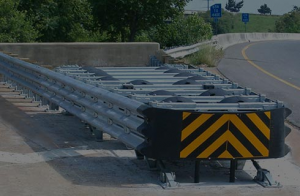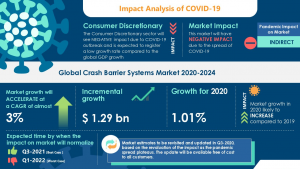Crash Barrier Systems Manufacturing Business. Most Lucrative Startup Opportunity
Crash Barrier Systems are robust protective barrier that is placed around a racetrack or in the middle of a two-lane roadway to help prevent serious accidents. These are systems that are installed along the roadside or between the two halves of a driveway to prevent accidents or, in some cases, to divert traffic. Fixed crash barriers are typically erected on the sides of roadways, road dividers. They are not required to move at any time. Portable crash barriers, on the other hand, are utilized where they may be moved as needed at any moment, such as for temporary detours while working on road repair. Crash barriers are designed to keep vehicles on the road. It is also used to prevent them from colliding with objects like trees and buildings. These crash barriers are installed in the medians of divided roads to keep vehicles from merging into the opposite lane of traffic and causing a head-on accident. Crash barriers are also utilized to protect potentially dangerous areas such as schoolyards and pedestrian walkways.

Start a Business in Industrial & Engineering Products Industry, Click Here
Opportunities for Crash Barrier Systems Manufacturing Industry:
The global crash barrier systems market is expected to increase at a CAGR of 3.3 % in the next six years from $7.6 billion to $9.0 billion. Owing to the investments in the development of roads, railways, and airports the global carrier barrier systems are projected to grow. Crash barrier systems are required for roadway development, such as roads, highways, and bridges, in order to limit the incidence of road disasters. The rising construction and automobile sectors around the world are driving the Crash Barrier Systems market. The global crash barrier market is growing due to the rising demand for flexible barrier systems that require a low cost of repair after crashes.
In addition, the expansion of infrastructure industries is a crucial element driving up demand for crash barrier systems. Crash barrier systems are widely used on roads, highways, and bridges, as well as airports, construction zones, and trains. Due to the increase in roadway building and the number of cars, these crash barrier systems are likely to acquire the most traction during the projection period.
The requirement for bollards in the passenger queue, security checkpoints, entrance, and departure, drop arms in-vehicle parking zones, and vehicle access is likely to grow as the airport network expands. The growth of the barrier systems market is projected to be aided by the expansion and modification of these forms of transportation. Furthermore, traffic authorities around the world have enacted legislation requiring the installation of crash barriers along highways, bolstering the barrier systems market's growth.
Related Business Plan: Highway Guard Crash Barrier, Traffic barriers, Highway Safety Guardrail (Roll Forming with Metal Beam and Galvanizing Plant)
Some developing countries, such as India, China, and Mexico, have developed road safety initiatives including Pedestrian Awareness Drives, and Road Signs and Symbols, Helmet Awareness Weeks which use crash barriers to raise awareness. This gives the crash barrier systems market in these nations a chance to expand leading to opportunities for Crash Barrier manufacturers globally. In recent years, Latin American countries like Brazil and Argentina have shown signs of progress. Owing to the growth of GDP, urbanization has massively increased in many countries. As a result, the crash barrier systems market in these countries has a lot of room to grow and open up more and more opportunities for crash barrier manufacturers.

Project Report on Materials:
The material report's objective is to aid and advise an entrepreneur in collecting accurate information on the project's material requirements. It includes vital details including raw material needs, a description of machinery, and the plant's manufacturing procedures. Plant capacity, project setup costs, operational capital requirements, expected sales, and profit are all included in the report.
Read Similar Articles: Engineering Goods Projects
The project exemplifies the complete (both quantifiable and qualitative) investigation of antique data, profits, crucial progresses, along with the critical policies espoused by vital establishments catering to project. This offers dynamic and in-depth visions in directive to illustrate the global market situation.
The materials offer a descriptive breakdown of the porter’s five forces study united with SWOT investigation so as to deliver commercial interrelated statistics and info’s. Porter’s five forces model understands the inclusive inexpensive scenario that is prevailing in the arcade. Furthermore, the SWOT analysis recognizes mutually the constructive and destructive traits of the project expansion which impacts the company evolution and development in directive to endure and subsist in the elongated route.
Our Pre-Feasibility Study Report includes the following items:
In addition, the pre-feasibility study includes a production value analysis, which includes raw material analysis, product fee trend, Mergers & Acquisitions, growth, key product suppliers, Crash Barrier Systems marketplace awareness charge, and manufacturing process analysis. Entrepreneur India did study on Crash Barrier Systems market dynamics, including industry growth drivers, challenging situations, opportunities, risk, restrictions, and hazards. In order to assist startups and entrepreneurs, the study also contains a market result characteristics analysis that focuses on technical advancement, consumer demand patterns, and external environmental exchange.
Watch Video: Business Plan-Roll Forming with Metal Beam | Highway Guard Crash Barrier and Galvanizing Plant.
For each of the product segments, the study offers a critical market analysis. A cost chain analysis provides detailed data on value generation at each level. The pre-feasibility research investigates the drivers and limits of the Crash Barrier Systems market, as well as their impact on demand during the forecast period.
The research also discusses all of the important variables that a company should think about before entering the Crash Barrier Systems industry. It is entirely based on current financial data and includes extensive information on the primary method flow, raw material needs, reactions, application costs, working fees, capital investments, predictions, and margins, among other things. Entrepreneurs, researchers, professionals, commercial business strategists, and anybody else who is interested in the Crash Barrier Systems industry should study this text. The study also looks at the major Crash Barrier Systems manufacturers' sales, value, market share, and long-term growth plans. The sales, length, quality, and estimates for the market are all mentioned.
Latest Market Trends of Crash Barrier Systems Industry:
Crash Barrier manufacturing businesses also keep an eye on improvements in barrier construction material quality and the ease with which they can be installed, which helps the crash barrier industry grow. The expansion of the crash barrier systems market is also due to an increase in public knowledge about the government's road safety measures for the protection of vehicle travelers and pedestrians. However, the cost of production and installation, as well as government requirements, may limit the crash barrier market's growth. The trend illustrates that the growth of the automotive sector has resulted in an increase in the number of vehicles on the road, which has resulted in an increase in the number of accidents and crashes. As a result of this increased awareness of road safety measures, the market for crash barrier systems has grown. The expansion of the crash barrier systems market is aided by increased investment in infrastructure development in developing nations such as India, Brazil, and Mexico. In addition, the government has implemented a number of safety measures. The need for crash barriers is predicted to increase as a result of this thesis.
Related Feasibility Study Reports: Industrial & Engineering Products, Manufactured Goods, Industrial Engineering Products. Mechanical, Engineering, Automobile Industries, Metal, Metallurgical, S.S. Utensil, Wire, Aluminum, Brass, Copper Products, LPG Cylinder and Valves
Report on the Advantages of Using Our Crash Barrier Systems Project:
The project report from Entrepreneur India covers competition research to assist firms in analyzing key competitors' market positioning and advertising strategies. The main participant study in the Crash Barrier Systems manufacturing industry project report includes each player's share of the internal marketplace, growth price, and market attractiveness in specific end users/areas. Entrepreneur India's project study on the Crash Barrier Systems market aids a business owner in making informed decisions in order to expand their market share and presence.
The global crash barrier systems market is fiercely competitive, and the sector faces major entrance barriers due to high start-up costs and regulatory restrictions. The project report assesses the global market's current state, as well as current trends and drivers, as well as the overall market environment. The researcher's in-depth vendor analysis aims to assist clients in improving their market function, and this project report follows suit by examining a number of significant Crash Barrier Systems marketplaces in depth.

Read our Books Here: Steel, Iron, Ferrous, Non-Ferrous Metals with Casting and Forging, Aluminium, Ferroalloys Technology
Crash Barrier Systems API Manufacturing Industry FAQs:
1. How Big Is the Crash Barrier Systems Market?
In the forthcoming years, the market for crash barrier systems will expand by $1.29 billion.
2. What Is the Growth Rate of Crash Barrier Systems Globally?
In the forthcoming years, the crash barrier systems market is estimated to develop at
a CAGR of 2.75 percent.
3. What Are the Driving Factors of The Crash Barrier Systems Market?
The following are the major elements that are propelling the crash barrier systems industry forward:
- Road safety programs are being implemented.
- Rising demand for flexible barrier systems that require a low cost of repair after crashes.
4. Who are the major participants in the market for crash barrier systems?
The key players in crash barrier systems global market are:
- Arbus Ltd.
- Tata Steel Ltd.
- Lindsay Corp.
- Nucor Corp.
- Hill & Smith Holdings Plc
- Avon Barrier Corp. Ltd.
- Transpo Inudstries Inc.
- NV Bekaert SA
- Trinity Industries Inc.
- Valmont Industries Inc.
Watch other Informative Videos: Industrial & Engineering Products, Manufactured Goods, Mechanical, Automobile, Metal, Metallurgical, Wire, Aluminum, Copper Products, LPG Cylinder
Conclusion:
Since of our robust practice in project consultation and market investigation, we at Entrepreneur India offer comprehensive statistics on the project, which fits all of the standards of an origination or tycoon and has a significant boom latent in the marketplaces. And we are optimistic that our report will support you make sound and well-informed professional verdicts. Our laborious and in-depth stratagem makes use of prevailing schemes to safeguard that the relevant material is accessible at the right time and that decision-making is enhanced.
See More Links:
Startup Consulting Services
Start a Business in Asia
Start a Business in Potential Countries for Doing Business
Best Industry for Doing Business
Business Ideas with Low, Medium & High Investment
Looking for Most Demandable Business Ideas for Startups
Start a Business in Africa
Start a Business in India
Start a Business in Middle East
Related Videos
Related Books
Related Projects
Related Market Research Reports
DD_Art2022
|